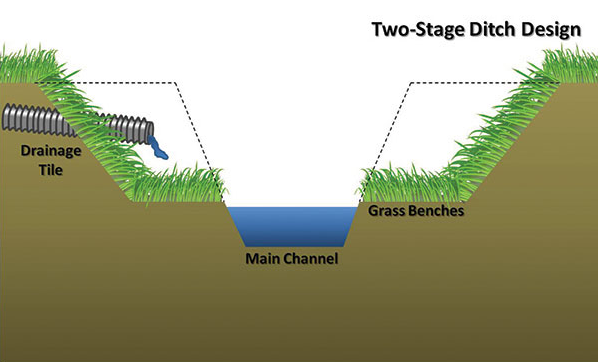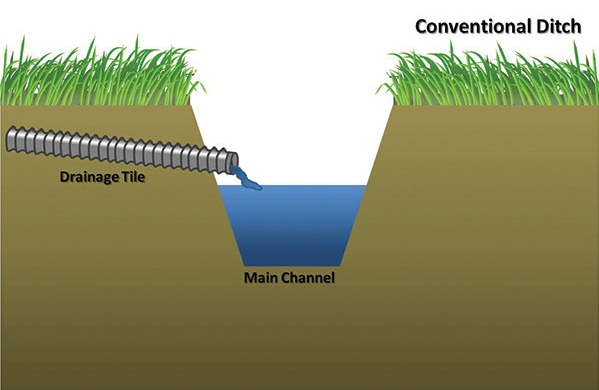Start today and lose up to 10 lbs. and 5 inches overall in your first month with the Nutrisystem® weight loss program. According to their spokesperson, the Nutrisystem® diet really works. For many hoping to shed those extra pounds, eating fewer calories is the key. But on the long road to optimal weight, the one thing that helps motivate a dieter is a good jump start plan. It’s that first 5, 7, or even 10 initial pounds lost that, in the beginning, makes the sacrifice all worth it. A quick jump start is a great idea and one that many diet plans use because losing weight is hard and early success is an important motivator.
I think the same thing is true for conservation. For those of us who want to help farmers get on the right path to improving water quality but don’t know exactly what to recommend, there might be a way to jump start the process using two-stage drainage ditches.

A couple of weeks ago I was talking to Dr. Jennifer Tank, Professor of Biological Sciences at Notre Dame. Dr. Tank believes agriculture could make immediate and long-term changes to nitrate levels just by reshaping drainage ditches…yes, she’s talking about those drainage ditches that are at the center of the now-famous lawsuit.
Could something as simple as reshaping drainage ditches really have an immediate and significant impact on surface water nitrate levels? It is very possible. Dr. Tank’s research carried out in Indiana demonstrates that nitrate removal capacity is 300% more as compared to conventional drainage ditches. Additionally, they measured significant reductions in turbidity. Talk about moving the needle. Two-stage ditches have the potential to be just the jump start famers need on the long road to conservation.
Indeed, the concept of the two-stage ditch is simple. The design creates a constructed flood zone (referred to as a mini-floodplain or “bench”) within the ditch. These benches are created by excavating the ditch banks roughly 20-30 inches above the ditch bottom, approximately tripling the width of the overall ditch. During storms, the water floods out over these benches to create a low velocity flow of water. During floodplain inundation of the two-stage ditch, water velocity is reduced, increasing water residence time and reducing nutrient export.

Advantages of two-stage ditches:
- Improves drainage
- Self-cleaning, so requires little maintenance (30yr plus life expectancy)
- Increases efficiency of nitrate-N removal due to increased surface area for biological removal
- Reduces flooding (greater water holding capacity)
- Increases bank stability resulting in less bank failure
- Filters particulate nutrients from water
- Benches increase denitrification rates by 350%
- Reduces sediments by nearly 60%
Disadvantages of two-stage ditches:
- More upfront cost to implement (but all practices take money)
- Takes slightly more ground out of production, if grass buffer strips are not already present
Just imagine a Best Management Practice (BMP) that doesn’t require every farmer to change their farming practices. It only affects a small portion of landowners and in a small way. It is permanent. It is effective. It helps to lower nitrogen, phosphorus, and sediment levels in water. And the efficacy of the practices improves over time.
Just like weight loss there is no magic pill for getting us to our goals for nutrient reduction. Two-stage ditches alone will not get us to our happy place. However two-stage ditches could be the jump start we all need to motivate us in the right direction. And the best part about this jump start is that two-stage ditches are permanent.
Learn more about two-stage ditches:
- Two-Stage Ditch Could Reduce Farm Runoff on Eastern Shore
- The two-stage ditch is a win-win for agriculture and conservation
- Alternative Design Options for Open Channels: Two-Stage Ditches and Self-Forming Channels
- Implementing Innovative Drainage Management Practices in the Mississippi River Basin to Enhance Nutrient Reductions

 Barriers to Private Sector Conservation Planning
Barriers to Private Sector Conservation Planning
As a point of reference, I wonder how wide the ditches would need to be compared to the Minnesota buffer strip implementation? Would two-stage ditches need more land than the regulated buffer zone width in Minnesota?
Chris, actually the width of the two-stage ditch would be less than the width of the regulated buffer strip regulated in Minnesota. I think it is something Minnesota needs to consider.